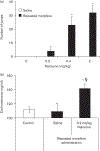Increased elevated plus maze open-arm time in mice during naloxone-precipitated morphine withdrawal
- PMID: 19020415
- PMCID: PMC11778593
- DOI: 10.1097/FBP.0b013e32831c3b57
Increased elevated plus maze open-arm time in mice during naloxone-precipitated morphine withdrawal
Abstract
Opioid withdrawal is known to be anxiogenic in humans and, using the elevated plus maze (EPM), was demonstrated to also be anxiogenic in rats. Thus, this study characterizes EPM behaviors of mice during naloxone-precipitated morphine withdrawal. Naloxone did not significantly change EPM behaviors of drug-naïve mice. Additionally, morphine-dependent mice in which withdrawal was not precipitated (i.e. morphine-dependent mice receiving saline) spent less time in the open-arms compared to the controls. Surprisingly, increased open-arm time was observed in morphine-dependent mice undergoing naloxone-precipitated withdrawal. This increase was not because of total motor activity, as no significant differences in total activity were observed. Moreover, morphine dependency was necessary, given that there was not a significant increase in open-arm time for mice undergoing withdrawal from acute morphine. Increased open-arm time during withdrawal is unexpected, given that opioid withdrawal is usually associated with anxiety. Additionally, even in mice, naloxone-precipitated morphine withdrawal is known be aversive and increases plasma corticosterone levels. In conclusion, this study demonstrates somewhat unexpected EPM behavior in mice undergoing naloxone-precipitated morphine withdrawal. Possible interpretations of these EPM results, though somewhat speculative, raise the possibility that EPM behaviors might not be driven exclusively by anxiety levels but rather by other withdrawal-induced behaviors.
Figures


References
-
- American Psychiatric Association DSM-IV (1994). Diagnostic and statistical manual of mental disorders. 4th ed. Washington, DC, USA: American Psychiatric Association.
-
- Belknap JK, Crabbe JC, Riggan J, O’Toole LA (1993). Voluntary consumption of morphine in 15 inbred mouse strains. Psychopharmacology (Berl) 112:352–358. - PubMed
-
- Belzung C, Dubreuil D (1998). Naloxone potentiates the anxiolytic but not the amnestic action of chlordiazepoxide in C57BL/6 mice. Behav Pharmacol 9:691–698. - PubMed
-
- Broseta I, Rodriguez-Arias M, Aguilar MA, Minarro J (2005). Isolation decreases physical and motivational aspects of morphine withdrawal. Behav Pharmacol 16:131–138. - PubMed
-
- Budziszewska B, Jaworska-Feil L, Lasoñ W (1996). Neurosteroids and the naloxone-precipitated withdrawal syndrome in morphine-dependent mice. Eur Neuropsychopharmacol 6:135–140. - PubMed
Publication types
MeSH terms
Substances
Grants and funding
LinkOut - more resources
Full Text Sources

